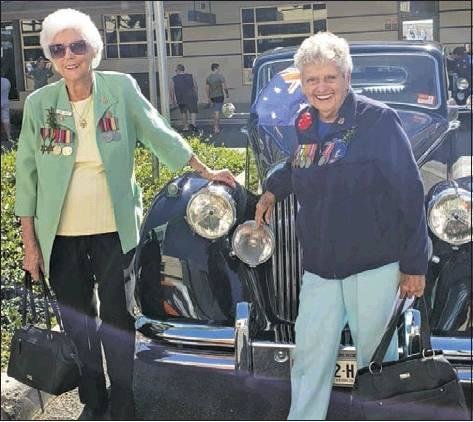Australia honors its war dead, survivors
Chronicle readers Gary and Mary Baker share more about their adventures in Australia and New Zealand.
Easter Sunday morning found our ship docked across the bay from the iconic Sydney Opera …
This item is available in full to subscribers.
Subscribe to continue reading. Already a subscriber? Sign in
Get 50% of all subscriptions for a limited time. Subscribe today.
Please log in to continueNeed an account?
|
Australia honors its war dead, survivors
Chronicle readers Gary and Mary Baker share more about their adventures in Australia and New Zealand.
Easter Sunday morning found our ship docked across the bay from the iconic Sydney Opera House. After a quick check-in at our hotel, we were off to see the sights of Sydney.
Our first stop was the nearby Christ Church St. Laurence. This Anglican Church founded in 1845 had a small crowd for the Easter Sunday service with the local archbishop presiding. The local priest gave an excellent sermon on the Resurrection.
One thing Mary and I noticed throughout our trip to New Zealand and Australia was the friendliness of the local folks.
We walked to the harbor through the Sunday Market and around the Opera House, through the beautiful Royal Botanical Gardens and the adjoining Governor’s House, home to the Governor of New South Wales.
In the ornate rooms were portraits of Queen Elizabeth, the head of the British Commonwealth, and our old antagonist, George III.
On the patio were busts of a number of ANZAC members who had been awarded the Victoria Cross for actions during World War I.
On our first full day back in country, we picked up a rental car.
2 years ago, Mary and I visited Ireland and Scotland, so I had some experience driving on the left side of the road. Stick shifts are cheaper to rent, however, I didn’t relish another distraction, so I opted for an automatic.
With the steering wheel on the right side of the car, it takes a little getting used to. The turn signal is on the right side of the steering column so it took several days before I got accustomed to not turning on the windshield wipers each time we made a turn.
Port Macquarie
On the way north to Port Macquarie, we stopped at a rest area where volunteers man a drink truck offering tea, coffee and snacks for free or donation. Australians are real high on “tired, relax, survive.”
Port Macquarie, a seaside village, was to be our headquarters for several days. There we explored some charity shops (opportunity or op shops) and antique stores before heading to the Koala Hospital.
Koalas as well as kangaroos are nocturnal creatures. Both are susceptible to being injured or killed on the roadways.
The hospital cares for injured or sick koalas. Because of their condition some remain there. Those deemed ready are released back into the wild.
Koalas spend about 20 hours a day sleeping, their diet consisting primarily of eucalyptus leaves.
Our visit ended with a tour of the Roto House, an 1890 structure built by a local land surveyor. It sits adjacent to the Koala Hospital and contains many artifacts and photos of the family which occupied it until 1979.
That evening, in need of clean clothes, we took a trip to the local laundromat. There we met an interesting couple from Tasmania. It was not on our agenda but we had heard it was a beautiful place to visit.
ANZAC Day
Soon after we arrived in Sydney, we noticed a sign saying the establishment was open except for April 25 and December 25.
A little poking around found that April 25 is ANZAC Day, somewhat of a combination of our Memorial Day and Veterans Day. Pretty much the whole country closes down on this national holiday to remember the sacrifices of the troops from New Zealand and Australia who served during the Great War (World War I) and subsequent conflicts.
ANZAC Day was a beautiful day with a sunrise program which we did not attend. However, the 10 o’clock service included a parade and speeches by local dignitaries.
Port Macquarie is a small town of about 46,000, probably up to 5,000 attended including veterans, boy and girl scout groups, emergency responders and school groups. Each provided a wreath laid at the base of the town’s cenotaph, a monument honoring those whose remains are elsewhere.
I spoke to a WWII veteran who confided that he was trained in the United States and appreciated all that the US did to win the war.
Afterward, we spoke to 2 WWII veterans in their mid-90s as they waited for their rides in antique automobiles. One had been a cook, the other a nurse.
After lunch at the Port Macquarie Hotel, we watched as folks played “2 up.” It is a game played by soldiers (called “Diggers” in WWI) with idle time in the trenches.
2 pennies are simultaneously tossed in the air using a little paddle. Folks bet on whether there would be two heads, two tails, or one head and one tail. It is illegal to play it except on ANZAC Day.
Local taverns host official “2-up” games, drawing large crowds.
We walked the local beach and picked up shells and rocks. We noticed at the beaches that there were few shells but the rocks appeared to be in patches, not strung out along the beaches.
On our way out of town, we visited the Billabong Zoo where we saw lots of different critters, kangaroos, koalas, wombats and dingos.
The zoo was not exactly like Riverbanks but the staff gave very informative talks. We were able to touch and pet the koalas and kangaroos. Then, we were off to Coff’s Harbor, several hours up the coast.
Next: Coff’s Harbor days
Other items that may interest you










Comments
No comments on this item Please log in to comment by clicking here